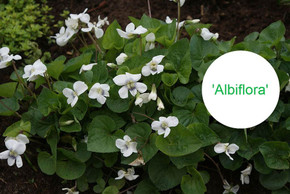
Viola striata - STRIPED CREAM VIOLET
Ground-covering native Viola for naturalization in partial shade or shade.
Beautiful small plant, not fussy about soils, tolerant to drier shade. Can become aggressive seeder or spreader, so the best use is in more natural areas.
Great wildlife support and host plant for larvae of several species of Fritillary Butterflies.
Blooming time : May/June
Size : 4-5” tall x 8-12" wide, clumps are more trailing, often leans against adjacent plants
USDA zones : 4 to 7
Culture : best in half shade, dappled shade, shade. Adaptable to various soil types, including clay. Appreciates some organic matter. Average moisture (medium), medium-moist, medium-dry. Tolerant to heat, humidity and some drought.
Moisture Needs : adaptable - from average to moist, moist/wet. Tolerates drier shade.
Origin : eastern half of USA, can be found in high quality natural areas to ares with minor or smaller disturbance. Moist to mesic deciduous woodlands, shaded stream banks, open woodlands, woodland borders, moist meadows, shrubby hedges, ditches. See the BONAP distribution map.
Deer/rabbit resistant : yes / yes
Attracts Butterflies or Pollinators : yes/ yes. Flowers offer nectar and pollen to native bees (incl. bumblebees, long-horned bees, mason bees, Andrenid bees and specialist Violet Andrenid Bee). Less effective pollinators are Giant Bee Fly, butterflies, and skippers. Host plant for caterpillars of Fritillary Butterflies (Great Spangled Fritillary, the Mormon Fritillary, the Silver-Bordered Fritillary, the Coronis Fritillary, the Edward's Fritillary, and the Variegated Fritillary). Other insect feeds on the leaves (gall flies, sawflies larvae, the caterpillars of various moths)
Attracts Hummingbirds / Other bird and wildlife support : no / To certain extend seeds consumed by some some upland gamebirds (Mourning Dove, Ruffed Grouse, Bobwhite Quail, Wild Turkeyand), small rodents (White-footed Mouse, the rhizomes are eaten by the Eastern Chipmunk).
Pot Size : square 3.5" x 4" perennial pot
Picture copyright : Andy Reago & Chrissy McClarren, Flickr
Plant combinations : Great plant for more natural areas in shade or half shade garden, woodland garden, underplanting bigger shrubs and trees.
Combined with grasses - Carex (sedges), Diarhenna, Deschampsia, or native Dicentra, Mainanthemum, Phlox stolonifera, Phlox divaricata, Polygonatum biflorum, Stylophorum diphyllum, Uvularia, etc. and native spring ephemerals (Jeffersonia, Mertensia, Sanquinaria, Trillium, etc) and ferns.

Viola striata - STRIPED CREAM VIOLET
Ground-covering native Viola for naturalization in partial shade or shade.
Beautiful small plant, not fussy about soils, tolerant to drier shade. Can become aggressive seeder or spreader, so the best use is in more natural areas.
Great wildlife support and host plant for larvae of several species of Fritillary Butterflies.
Blooming time : May/June
Size : 4-5” tall x 8-12" wide, clumps are more trailing, often leans against adjacent plants
USDA zones : 4 to 7
Culture : best in half shade, dappled shade, shade. Adaptable to various soil types, including clay. Appreciates some organic matter. Average moisture (medium), medium-moist, medium-dry. Tolerant to heat, humidity and some drought.
Moisture Needs : adaptable - from average to moist, moist/wet. Tolerates drier shade.
Origin : eastern half of USA, can be found in high quality natural areas to ares with minor or smaller disturbance. Moist to mesic deciduous woodlands, shaded stream banks, open woodlands, woodland borders, moist meadows, shrubby hedges, ditches. See the BONAP distribution map.
Deer/rabbit resistant : yes / yes
Attracts Butterflies or Pollinators : yes/ yes. Flowers offer nectar and pollen to native bees (incl. bumblebees, long-horned bees, mason bees, Andrenid bees and specialist Violet Andrenid Bee). Less effective pollinators are Giant Bee Fly, butterflies, and skippers. Host plant for caterpillars of Fritillary Butterflies (Great Spangled Fritillary, the Mormon Fritillary, the Silver-Bordered Fritillary, the Coronis Fritillary, the Edward's Fritillary, and the Variegated Fritillary). Other insect feeds on the leaves (gall flies, sawflies larvae, the caterpillars of various moths)
Attracts Hummingbirds / Other bird and wildlife support : no / To certain extend seeds consumed by some some upland gamebirds (Mourning Dove, Ruffed Grouse, Bobwhite Quail, Wild Turkeyand), small rodents (White-footed Mouse, the rhizomes are eaten by the Eastern Chipmunk).
Pot Size : square 3.5" x 4" perennial pot
Picture copyright : Andy Reago & Chrissy McClarren, Flickr
Plant combinations : Great plant for more natural areas in shade or half shade garden, woodland garden, underplanting bigger shrubs and trees.
Combined with grasses - Carex (sedges), Diarhenna, Deschampsia, or native Dicentra, Mainanthemum, Phlox stolonifera, Phlox divaricata, Polygonatum biflorum, Stylophorum diphyllum, Uvularia, etc. and native spring ephemerals (Jeffersonia, Mertensia, Sanquinaria, Trillium, etc) and ferns.




